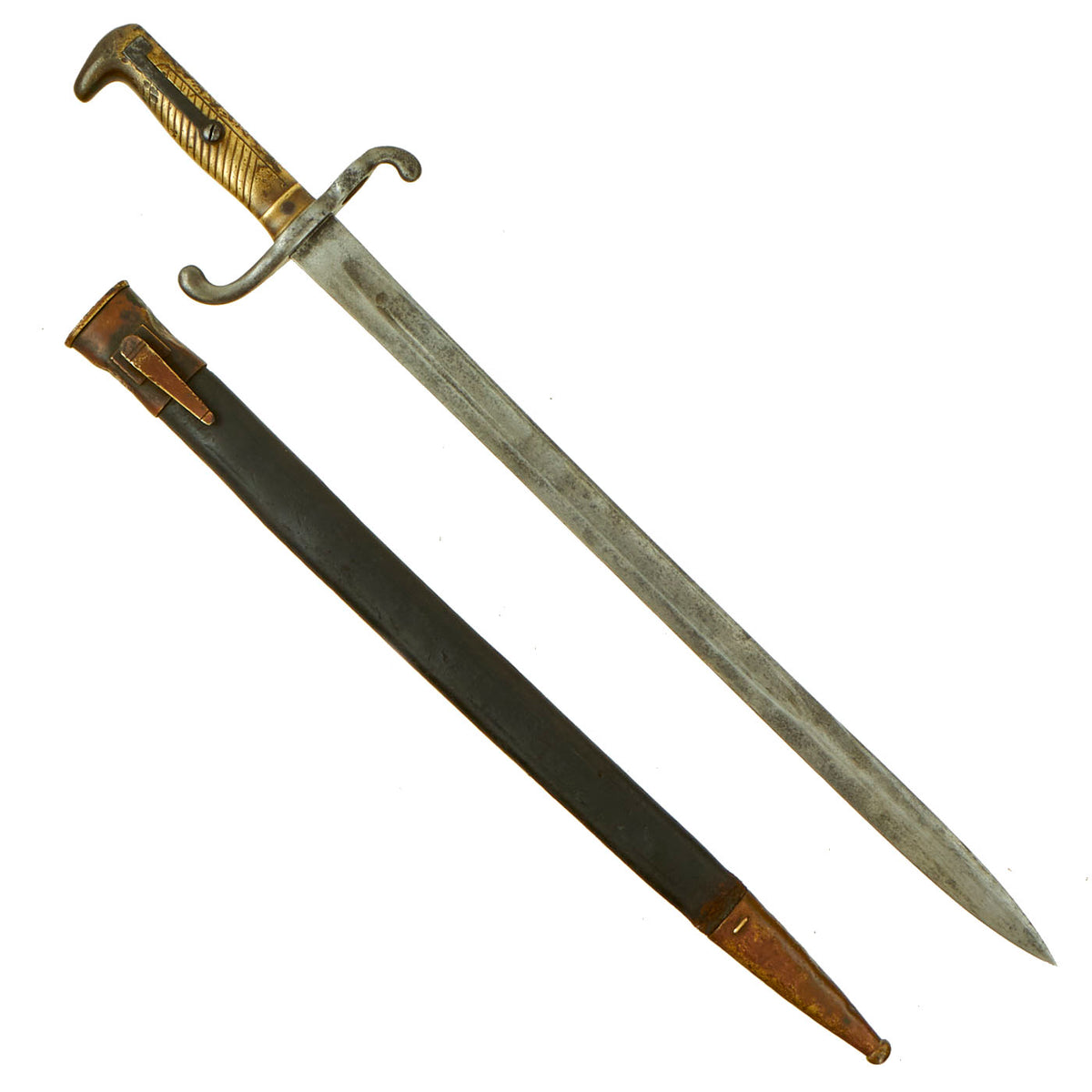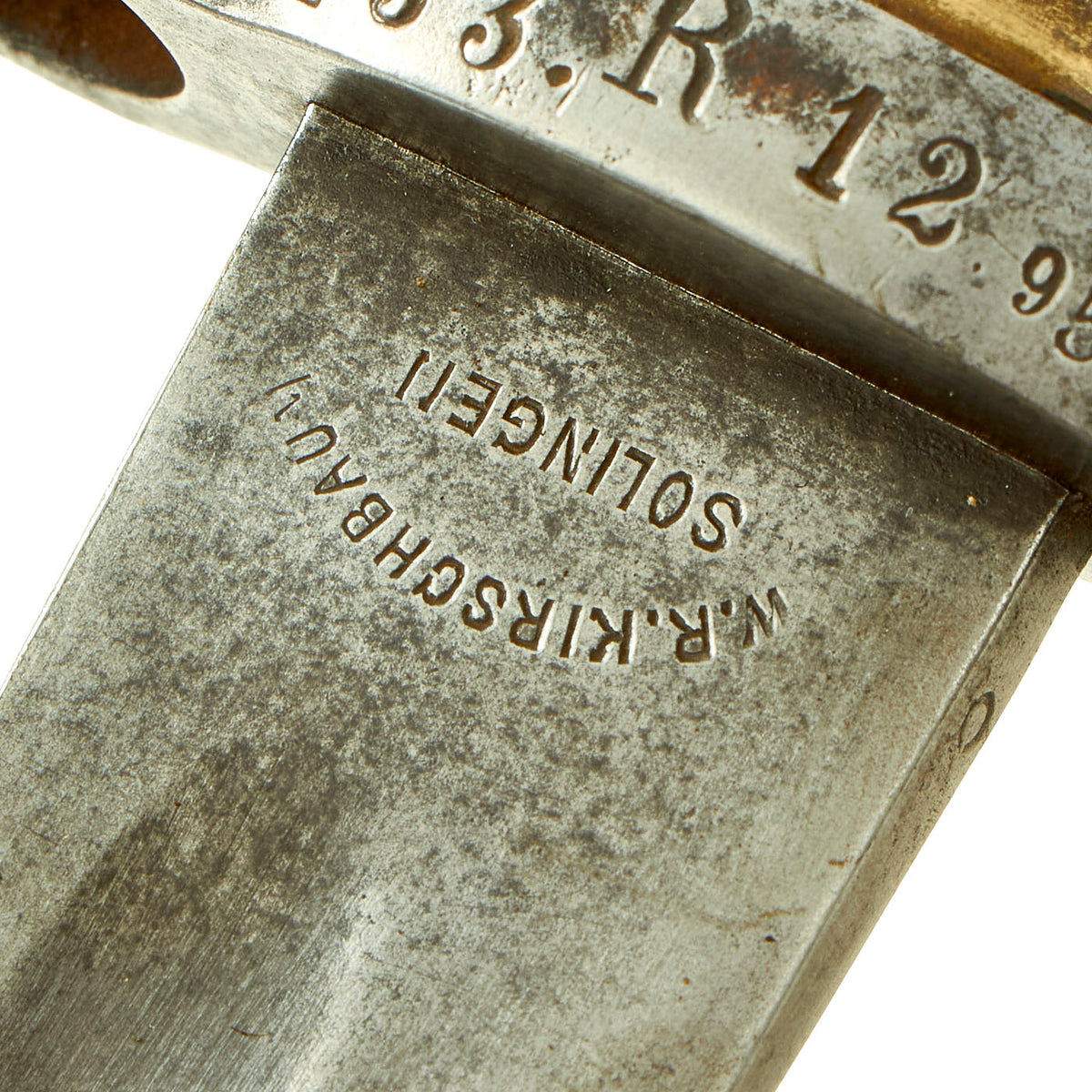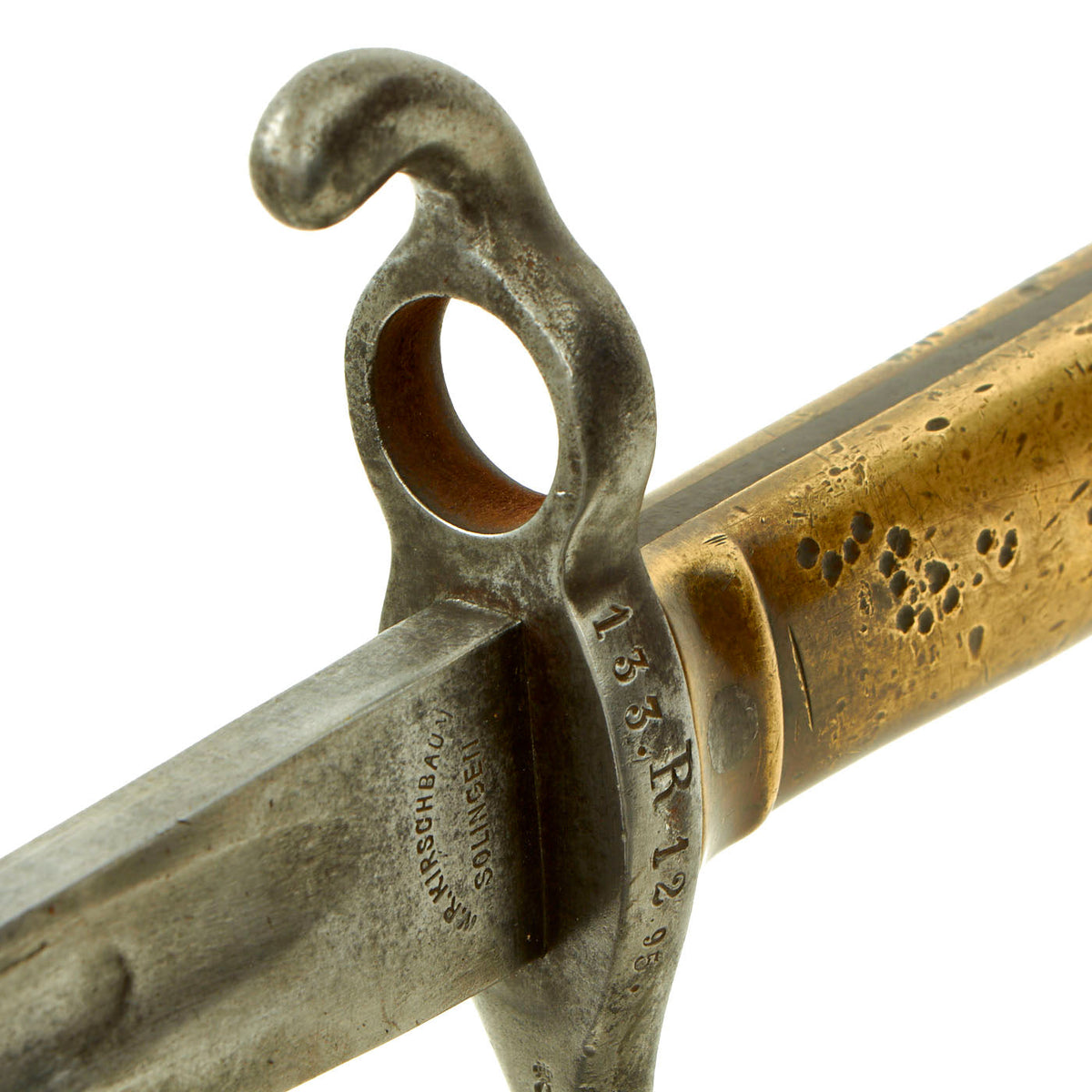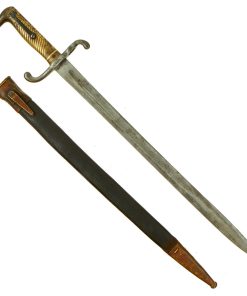Original German Mauser Model 1871 Rifle Bayonet by W.R. Kirschbaum with Scabbard – Regiment Marked Original Items
$ 595,00 $ 178,50
Original Item: Only One Available. This is a very good example of the Mauser Model 1871 rifle bayonet with brass hilt, complete with the original brass-fitted leather scabbard. The bayonet is in good condition, and is not marked on the rear of the blade.
The steel blade is 18 ½” long and is in very good condition, and has not had the main edge sharpened at any time, so it still has the factory blunt edge. It has some light staining and pitting, but overall looks great.
The blade ricasso is maker marked W.R. KIRSCHBAUM / SOLINGEN. This is actually a somewhat rare maker in itself, as the company only existed from 1870 to 1883, when Wilhelm Reinhard Kirschbaum died. His heirs elected to Amalgamate with Gebrüder Weyersberg, forming the Legendary Weyersberg Kirschbaum &Co. For more information on this maker please see J Anthony Carter’s excellent work GERMAN KNIFE AND SWORD MAKERS.
The handle of the blade is in good condition, and has a fully functional bayonet latch. There are also some proof marks, as is typical on Imperial German bayonets. The steel “S” shaped crossguard does have a bit of oxidation in areas, and bears regimental marking 133.R 12 95. This indicates issue to the 133rd Royal Saxon Reserve Regiment of the XII Royal Saxon Reserve Corps which fell under the 24th Reserve Division. The XII (Royal Saxon) Reserve Corps (German: XII. (Königlich Sächsisches) Reserve-Korps / XII RK) was a corps level command of the German Army in World War I. XII Reserve Corps was formed on the outbreak of the war in August 1914 as part of the mobilization of the Army. It was initially commanded by General der Artillerie Hans von Kirchbach, recalled from retirement. It was still in existence at the end of the war in Armee-Abteilung C, Heeresgruppe Gallwitz on the Western Front. The Royal Saxon 24th Reserve Division (Kgl. Sächsische 24. Reserve-Division) was a unit of the Imperial German Army in World War I. The division was formed on mobilization of the German Army in August 1914 as part of the XII (Royal Saxon) Reserve Corps. The division was disbanded in 1919 during the demobilization of the German Army after World War I. The division was raised in the Kingdom of Saxony.
The bayonet comes complete with its original brass mounted black leather scabbard bearing bearing a different regimental marking: 177. R.2.97. These markings indicate the 177th (12th Royal Saxon) Infantry who also fell under the XII Army Corps. There are additional proof marks on the hilt and drag of the scabbard. The scabbard is in good condition, however there is some deformation and stitching degradation and the throat springs are VERY strong, and it requires quite a bit of effort to remove and replace the scabbard.
A very nice example of this relatively rare bayonet, ready to display!
Specifications:
Blade Length: 18 ½”
Blade Style: Single Edge with Fuller
Overall length: 23 1/2“
Crossguard: 4 5/8”
Scabbard Length: 19″
The Mauser Model 1871 adopted as the Gewehr 71 or Infanterie-Gewehr 71, or “Infantry Rifle 71” (“I.G.Mod.71” was stamped on the rifles themselves) was the first rifle model in a distinguished line designed and manufactured by Paul Mauser and Wilhelm Mauser of the Mauser company and later mass-produced at Spandau arsenal.
Paul Mauser developed his bolt-action rifle from 1867 to 1871. During 1870–71 trials with many different rifles took place, with the “M1869 Bavarian Werder” being the Mausers’ chief competitor. The Mauser was provisionally adopted on 2 December 1871, pending the development of an appropriate safety. With support from the government’s Spandau arsenal, the improvements to the safety mechanism were completed and the rifle was formally accepted on 14 February 1872 as Infantry Rifle Model 1871 by the German Empire excluding Bavaria. General issue to troops began in late 1873 and all units had been converted by the spring of 1875. The Mauser 1871 was replaced by the magazine-fed, smokeless powder using Gewehr 1888 from 1888 through 1890.
Fast Shipping with Professional Packaging
Thanks to our longstanding association with UPS FedEx DHL, and other major international carriers, we are able to provide a range of shipping options. Our warehouse staff is expertly trained and will wrap your products according to our exact and precise specifications. Prior to shipping, your goods will be thoroughly examined and securely secured. We ship to thousands clients each day across multiple countries. This shows how we're dedicated to be the largest retailer on the internet. Warehouses and distribution centres can be located throughout Europe as well as the USA.
Note: Orders with more than one item will be assigned a processing date depending on the item.
Before shipping before shipping, we'll conduct a thorough inspection of the items you have ordered. Today, the majority of orders will be delivered within 48 hours. The delivery time will be between 3-7 days.
Returns
The stock is dynamic and we cannot completely manage it because multiple stakeholders are involved, including our factory and warehouse. So the actual stock may alter at any time. It's possible that you may not receive your order once the order has been made.
Our policy is valid for a period of 30 days. If you don't receive the product within 30 days, we are not able to issue a refund or an exchange.
You can only return an item if it is unused and in the same state as the day you received it. You must have the item in its original packaging.
Related products
Uncategorized
Uncategorized
Uncategorized
Uncategorized
Uncategorized
Uncategorized
Uncategorized
Uncategorized
Uncategorized
Angolan Rebel 1970s era 60mm Inert Display Mortar from Angolan Civil War Original Items
Uncategorized
Uncategorized
Uncategorized
Uncategorized
Armored Burgonet Helmet & Polearm from Scottish Castle Leith Hall Circa 1700 Original Items
Uncategorized
Uncategorized
Australian WWII Owen MK1 Machine Carbine SMG Custom Fabricated Replica with Sling Original Items
Uncategorized
Uncategorized













































































